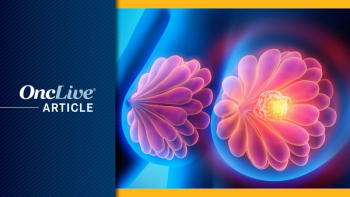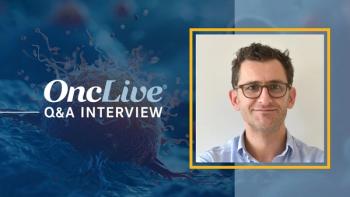
Volasertib Given Breakthrough Therapy Designation for AML
The novel PLK1 inhibitor volasertib in combination with low-dose cytarabine has received a Breakthrough Therapy designation from the FDA for its potential as a treatment for patients with untreated AML.
Structure of the PLK1 protein
The novel polo-like kinase 1(PLK1) inhibitor volasertib in combination with low-dose cytarabine (LDAC) has received a Breakthrough Therapy designation from the FDA for its potential as a treatment for patients with untreated acute myeloid leukemia (AML) who are ineligible for intensive remission induction therapy.
PLKs function as important regulators of the cell cycle and are involved in the activation of cyclin-dependent kinases and maintenance of genomic stability. In preclinical evidence exploring the PLK family, PLK1 was identified as holding the most potential for targeted cancer therapies, since it is commonly overexpressed in many tumor types. As an antimitotic target, PLK1, which is only expressed in dividing cells, plays an essential role throughout many stages of mitosis. As an antagonist of PLK1, the first-in-class agent volasertib is thought to induce mitotic arrest and apoptosis in cancer cells.
The FDA's Breakthrough Therapy designation will help expedite Boehringer Ingelheim's development of volasertib. The program is intended to potentially speed up the review process for treatments for serious or life-threatening conditions. The relatively new designation provides similar benefits to the FDA's fast track designation, although the two are separate programs. Unlike the fast track designation, a Breakthrough Therapy must demonstrate preliminary clinical evidence and represent a substantial improvement over available therapies.
“This FDA Breakthrough Therapy designation provides Boehringer Ingelheim the opportunity to engage in an ongoing dialogue with the FDA to help expedite the development of volasertib as a potential treatment option for these patients with AML,” said Sabine Luik, MD, the senior vice president of Medicine & Regulatory Affairs and the US Regional Medical Director for Boehringer Ingelheim Pharmaceuticals, Inc, in a statement issued by the company.
The Breakthrough Therapy designation was granted based on results from a phase II study presented at the 2012 American Society of Hematology annual meeting. In this study, patients with previously untreated AML who were ineligible for intensive treatment were randomized to receive either intravenous volasertib in combination with LDAC or LDAC alone. Preliminary results from the trial demonstrated significant improvement in the primary endpoint of objective response (measured as complete remission [CR] or CR with incomplete blood count recovery [CRi]). Additionally, a trend was observed in favor of the combination for the secondary endpoint of event-free survival (EFS).
In the study, 87 patients were randomized in a 1:1 ratio to receive volasertib plus LDAC (n=42) or LDAC alone (n=45). Treatment was repeated every 4 weeks until progression for a median of 2 cycles. The maximum tolerated dose for volasertib of 350 mg was administered on days 1 and 15 and LDAC was administered at 20 mg twice daily subcutaneously on days 1-10. The median age for patients in the trial was between 75 and 76 years.
At the time of the analysis, 31% of patients receiving the combination achieved a CR or CRi compared with 11.1% in the control arm (Odds ratio 3.59; 95% CI, 1.15-11.18]; P = 0.0277). The median time to remission in the volasertib arm was 71 days compared with 69 days in the control arm.
A trend toward an advantage in EFS was observed in the volasertib arm, with a median EFS of 169 days compared with 69 days for patients who received LDAC alone (Hazard Ratio [HR] = 0.61; 95% CI, 0.35 - 1.05; P = 0.0725). At the time of the analysis, the secondary endpoint of overall survival was not yet available, since only 2 patients had experienced recurrence or death. In total, the remission duration with the combination was 53—407 days compared to 32–282 days with LDAC alone.
Adverse events were more frequent with the combination of volasertib and LDAC and were inline with those expected with the agent's myelosuppressive mechanism of action. However, early death rates were similar between the two arms at 30, 60, and 90 days.
The most common all grade events observed in patients who received volasertib combination were febrile neutropenia (50%), constipation (45.2%), nausea (40.5%), and anemia (40.5%). The most common events observed in the LDAC arm were nausea (33.3%), anemia (28.9%), pyrexia (28.9%), constipation (26.7%), asthenia (26.7%), and diarrhea (26.7%) in the LDAC arm. In all, 95.2% of patients experienced grade 3 or higher events with the combination compared with 68.9% with LDAC alone.
Following the presentation of these findings, a phase III confirmatory analysis was initiated in January 2013. In this study, labeled POLO-AML-2, volasertib plus LDAC is being compared with LDAC and placebo as a treatment specifically for patients aged 65 years old or older with previously untreated AML who are ineligible for intensive remission induction therapy. The trial is currently enrolling patients with the first patient entering the trial in February 2013.
In addition to volasertib, Boehringer Ingelheim is investigating several agents in phase III clinical trials for a variety of diseases, including non-small cell lung cancer (NSCLC), breast cancer, ovarian cancer, and head and neck cancer. In July 2013, the company received its first oncology approval for afatinib as a treatment for patients with EGFR-mutant advanced NSCLC.
“Volasertib is one of many investigational compounds in Boehringer Ingelheim's growing oncology pipeline and is an example of our commitment to exploring treatment approaches with the goal of improving patient outcomes,” Luik said, in a release.
Maertens J, Lübbert M, Fiedler W, et al. Phase I/II study of volasertib (BI 6727), an intravenous polo-like kinase (PLK) inhibitor, in patients with acute myeloid leukemia (AML): results from the randomized phase II part for volasertib in combination with low-dose cytarabine (LDAC) versus LDAC monotherapy in patients with previously untreated AML ineligible for intensive treatment. Presented at: 54th American Society of Hematology Annual Meeting and Exposition; December 8-11, 2012; Atlanta, Georgia. Abstract 411.

























































































